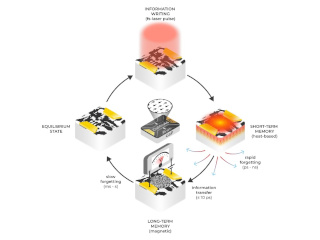
Analog magnetic memory
We published a study on analog magnetic memory in a newly deployed journal Newton.
Compensated magnets have potential for approaching the limit of fastest and least-dissipative operation of memory devices. So far, mainly digital memories made from these materials have been investigated, but for certain applications it is more advantageous to use analog memories.
In their article published in the journal Newton (https://doi.org/10.1016/j.newton.2025.100034) Surýnek et al. demonstrated the operation of an analog memory device based on layers of antiferromagnet CuMnAs. They showed that two types of memory exist simultaneously in this device. Short-term memory is based on heat dynamics, which occurs on a time scale of picoseconds to hundreds of nanoseconds. When the threshold temperature for inducing a change in magnetic ordering of CuMnAs is reached, the electrical resistance of the device increases. Thanks to this, information about input stimuli, represented by femtosecond laser pulses, is transferred from short-term thermal memory to long-term magnetic memory, where it is stored on a time scale of tens of milliseconds to tens of seconds.


